I know it seems early to be thinking about Christmas books, but folks have been hankering for them at the store the past few weeks. So, we dutifully set up a small display (I refuse to go whole hog until the first hard frost) the other day. As I looked at the books I started thinking about my family favorites. The books we read as children and the books I read every year with my family.
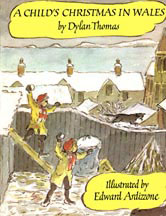 I think the book that we always go to is A Child’s Christmas in Wales. My partner and I take turns reading the book aloud while one of us cooks or wraps presents. The gorgeous language captivates us each time. It’s a lovely tradition and one we try to take time for every year.
I think the book that we always go to is A Child’s Christmas in Wales. My partner and I take turns reading the book aloud while one of us cooks or wraps presents. The gorgeous language captivates us each time. It’s a lovely tradition and one we try to take time for every year. 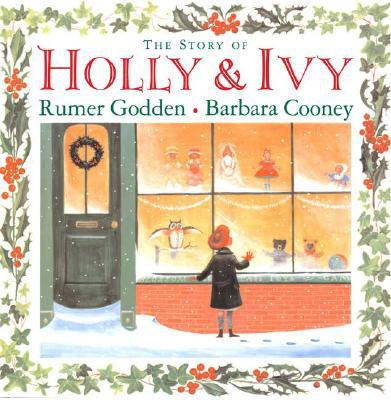
The Story of Holly and Ivy with its glorious illustrations is a lovely picture book to share during the holidays. Every year it seems we always run out of this book about an orphan searching for family, a doll yearning for a girl, and a couple wishing for a child to share Christmas with.
One of our store’s bestselling holiday picture books is also one of our favorites. Mr. Willowby’s Christmas Tree tells the story of a too-tall 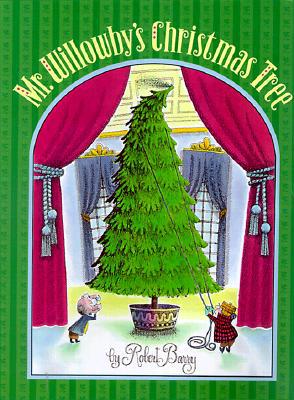 Christmas tree and the folks, and mice, who each get part of it as their tree. The rhyming text is great for littler kids and the illustrations are best described as jaunty and fun. This book is perfect with hot chocolate with marshmallows that are just starting to melt.
Christmas tree and the folks, and mice, who each get part of it as their tree. The rhyming text is great for littler kids and the illustrations are best described as jaunty and fun. This book is perfect with hot chocolate with marshmallows that are just starting to melt.
One of my all-time favorites is How the Grinch Stole Christmas. I think folks sometimes forget  that it was a book first, before the cartoon. The language of this Seuss classic has stayed with me my whole life – I feel like I could recite it from memory, I’ve heard it so often. A great book to read to the kids before you see the film.
that it was a book first, before the cartoon. The language of this Seuss classic has stayed with me my whole life – I feel like I could recite it from memory, I’ve heard it so often. A great book to read to the kids before you see the film.
I also love The Night Before Christmas. One of the beauties of this book is every year at least one or two newly illustrated 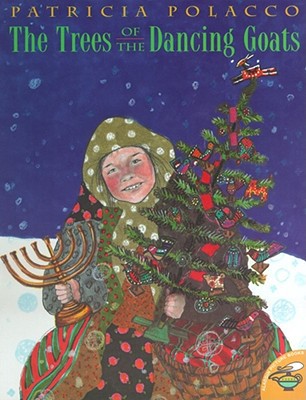 versions come out, so I can add to my collection if there’s one that I particularly love. And lastly, The Tree of the Dancing Goats is one that gets read every year with my nephews, who celebrate both Christmas and Hanukkah. This lovely story of friendship celebrates both religious holidays in a joyful way, and, I always try to make sure that we’ve got latkes when we’re done reading.
versions come out, so I can add to my collection if there’s one that I particularly love. And lastly, The Tree of the Dancing Goats is one that gets read every year with my nephews, who celebrate both Christmas and Hanukkah. This lovely story of friendship celebrates both religious holidays in a joyful way, and, I always try to make sure that we’ve got latkes when we’re done reading.
Readers, please share with us what some of your family holiday reading traditions are. And while it does seem awfully early to think about holiday books, by sharing now, you’ll give some of us booksellers a little more time to get those treasures in our stores.
Events and Candy
Josie Leavitt - November 2, 2011
We are blessed with customers who like to thank us. Sometimes, we get notes in the mail saying how much a book has touched a customer, or folks stop me in the market to say thanks. I love all of this. It reminds me why I work at an indie bookstore.
This past week we had two people thank us with food. The first was a woman whose daughter was finishing her internship at the Shelburne Museum. Denise had been telling her mom about the store since May when she first came in. We connected easily over books and she was very excited about our event with Judith Jones. And so was her mother, who planned a trip to visit from Virginia the weekend of the event.
This past weekend Denise and her mom (who was back to help Denise move back home) came into the store to say goodbye. But also, Denise’s mom had to share something with me. She wiped back a tear as she told me how much meeting Judith Jones meant to her and how moving she found the event. Honestly, that was more than enough to make my day, but then she said she had a little something for us. She made us a pound of homemade toffee candy with nuts and chocolate. The staff was in heaven. For her to have gone to the trouble to make toffee was as moving as it was delicious.
Then another customer came in with a note and gift. She practically fled as she handed it to me. I opened it to find a container of candy corn and a lovely note. We had sold books at the David Sedaris event earlier in the month when he came to Burlington. Part of our contract was having a raffle for four front-row seats. Debbie had won a pair. In her note she said how necessary it was to just laugh and how intense it was to have David Sedaris “right there in front of me.” I’m not sure what was going in her life, but I got the sense the Sedaris event made it all better for a little while.
These two women reminded me of the power of bookstore events. Events create richness; people can meet lifelong heroes, spend an evening forgetting what’s troubling them, or just spend a spirited night discussing books. And if folks want to thank me with some candy, well, that’s just a sweet bonus.
And The Beep Goes On
Josie Leavitt - October 31, 2011
Yesterday the store’s inventory was counted. This is an hours long procedure involving eight trained people from the inventory counting company. Our fiscal year is a flexible thing, so we can get inventory done when it works for us. And what worked this year was the day before Halloween.
I awoke to a sore throat and snow; it’s not every day I have to be at work at 6:45 a.m. Before the inventory I went to the bagel place and got a dozen bagels and a “Brew for the Crew.” It just seemed like the most civilized way for these eight people to start counting all my books, toys and games. Each worker came in wearing their gear: a belt pack with a key pad that hooks into a finger scanner. The scanner beeps every time an item is scanned. That’s what I called the happy beep. Then there’s the honk it makes when it scans something that’s not in your inventory.
Getting organized for inventory takes a ton of work. It’s a nightmare for me because it forces me to deal with my hidden corners of, well, crap. I am put in a position of deciding what to with all the books, toys, games, cards, etc. What do we want counted? Obviously, all the books, but do we really need a count of the three magazines we sell monthly that are just automatically replaced? Um, not so much.
The beauty of doing inventory now is we will know exactly where everything for the holidays. So, when a customer comes in looking for that obscure history book and we can’t find it, we turn to the Missing Book Locator and look it up by ISBN and it will tell precisely where to find that book. I must say, after 15 years of bookselling, there is nothing more satisfying than being the magician pulling the rabbit out of the hat for some happy customer.
The folks doing the inventory were amazingly fast. So I heard lots of beeps from all the parts of the store. In two hours they had counted over 7,000 items. And once they were all fully awake, they just flew. Really, it was kind of mind-boggling.
I know I’m paying these folks, but I’m full of gratitude that they can come in and in just a few hours tell me what my whole inventory is. And the coffee stayed hot until they were done.
Hey, How Are You?
Josie Leavitt - October 28, 2011
It’s happened to me more than I care to admit. A lovely customer comes in and says, “Hi, Josie!” And I look at him or her and I have no earthly clue who they are. I know that I know who they are. I’ve seen them a bazillion times in the store and around town, but for whatever reason on this particular occasion, I cannot recall their name. And it’s clear I should know them, and to ask them what their name is would be insulting. So I respond with a hearty, “Hey, how are you?”
So, what’s a bookseller to do? Well, if you’re me, you wait, patiently, and hope the conversation will trigger some glimmer of memory for what their name is. Secretly, I hope a spouse or child will come in and then the much needed light bulb will go off. This doesn’t happen as often as it could. Usually, I find myself grasping at straws racking my brain all the while offering good book recommendations. Often times the customer has no real idea that I’m struggling so hard.
The real challenge comes with checkout and our Frequent Buyers Club, which is name-based. I am saved in this regard because 99% of our customers pay with check and credit cards, so I can discreetly add their name into their account to give them the right credit. Every day, I see dozens of people and while I like to think I know everyone who walks in my store, but realistically, my brain can only hold so many things. I try to make it a point to remember the children’s names. While there are days when I can’t remember names of frequent shoppers, there are also times, like last night, where I remember the name of a customer I haven’t seen in four years. What helps me the most is the staff who will often chime in their own happy greeting, thereby cuing me and relieving me of my agony.
Memory is a funny thing. It’s usually there when I need it, but when it fails me, it does so in grand fashion. I’m curious how other booksellers deal with the inability to recall a good customer’s name.
Picture Book Idea Month, Proclamations, and Florence Parry Heide
Elizabeth Bluemle - October 27, 2011
 Picture book writers, start your engines! Next month, when all the NaNoWriMo (National Novel Writing Month) enthusiasts are sweating over their keyboards to produce 50,000 words in 30 days, you, too, can suffer for your art. It’s time for the third official season of writer Tara Lazar’s brain child: Picture Book Idea Month, or PiBoIdMo (which my brain always converts to Pie-BOLD-mo, which then becomes piebald mo, which, oh, never mind).
Picture book writers, start your engines! Next month, when all the NaNoWriMo (National Novel Writing Month) enthusiasts are sweating over their keyboards to produce 50,000 words in 30 days, you, too, can suffer for your art. It’s time for the third official season of writer Tara Lazar’s brain child: Picture Book Idea Month, or PiBoIdMo (which my brain always converts to Pie-BOLD-mo, which then becomes piebald mo, which, oh, never mind).
I’ll quote snippets from her website to whet your appetites:
Do you think you can meet the PiBoIdMo challenge and create 30 new picture book ideas in 30 days? Well then, sign up [link added by ShelfTalker] for all the craziness! The concept is to create 30 picture book ideas in 30 days. You don’t have to write a manuscript. The object is to heighten your picture-book-idea-generating senses. Ideas may build upon other ideas and your list of potential stories will grow stronger as the days pass. By the end of the month, you’ll have a file of ideas to help inspire you throughout the year. Those who sign up for Picture Book Idea Month will be eligible for prizes—and oh, are there prizes this year! Signed books, picture book critiques, original art by picture book illustrators, book jewelry, hand-made journals, vintage children’s books, and feedback from one of three literary agents.
There’s a terrific list of guest bloggers who will be inspiring participants throughout the month.
PiBoIdMo and NaNoWriMo and similar endeavors are delightful and energizing. I think they can help focus and sustain those elusive pinpoints of brilliance and inspiration that creative people live for, and help get procrastinating and/or perfectionist writers our of their own heads and back to work. My writer friend Freeman Ng has a marvelous blog called Haiku Diem, in which he creates a new haiku each day; this project is now going into its second year. That’s inspiring. And my artist friend Kevan Atteberry has been creating a Monster a Day all month long, and delighting his pals on Facebook with them.
What I like about PiBoIdMo is that it’s customizable: you can nudge it to suit your needs. Perhaps you want to draft one perfect sentence every day (too ambitious? one sentence that makes you laugh out loud, then, perhaps), or create a new character sketch every day.
If you do participate in PiBoIdMo, consider doing so with a nod to this week’s wonderful Proclamation from a group of picture book writers and illustrators exhorting a more widely supported return to high standards, innovation, and excellence in our craft.
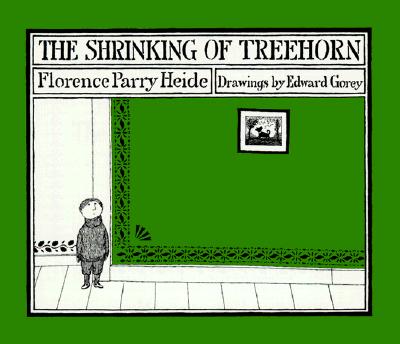 And do so with a warm, appreciative thought for that most innovative, excellent, original and untamed picture-book author, Florence Parry Heide, whose genius mind brought us, among many other titles, the marvelous The Shrinking of Treehorn, illustrated by Edward Gorey. We were very sorry to hear that Ms. Heide passed away this week (the Washington Post has a nice, if brief, write-up here) at the age of 92. She was a writer of economy and sharp wit, and we would all do well to aspire to even a little of her inventive spark.
And do so with a warm, appreciative thought for that most innovative, excellent, original and untamed picture-book author, Florence Parry Heide, whose genius mind brought us, among many other titles, the marvelous The Shrinking of Treehorn, illustrated by Edward Gorey. We were very sorry to hear that Ms. Heide passed away this week (the Washington Post has a nice, if brief, write-up here) at the age of 92. She was a writer of economy and sharp wit, and we would all do well to aspire to even a little of her inventive spark.
So, come on, folks, get ready, get set, and…. GO!
Publishers: Want to Improve Sales?
Elizabeth Bluemle - October 26, 2011
I can’t stand it another second: one too many hideous book jackets has entered my life and I don’t understand why. Recognizing an unsellable jacket is not rocket science—or perhaps that’s just true for anyone who works in retail bookselling. When my colleagues and I gather at various conferences and share books we love, we are almost always in universal agreement about which covers are fantastic (or at least passable) and which ones will never, ever voluntarily be picked up by a child or teen (not to mention parents, grandparents, teachers and librarians).
When a bad cover comes in on a book we love, we must resort to all kinds of games to bypass a customer’s automatic rejection. We booktalk it before actually revealing the cover, shielding it with our hands like something radioactive or hiding it in the middle of a stack of contenders. Once the time comes that we must finally show the book to the reader, we are forced to reassure kids that the story inside is fantastic; I’d like for someone from the art and marketing departments to come to the store and just once attempt to overcome the dubious, disgusted, and/or glazed looks on the faces of kids totally turned off by bad covers.
What makes for a bad cover? Any number of things, I’m afraid, from misleading graphics that don’t match a book’s content to amateurish artwork to unfortunate character depictions (for some reason, illustrated close-ups of faces staring out at the viewer almost always are a turn-off for kids; if someone can think of exceptions, chime in; I can’t think of any). Obviously, book cover budgets vary, but it seems like shooting oneself in the foot to pay for mediocre art or design and then expect a book that doesn’t have much marketing support to begin with to sell itself with a crummy jacket.
Another turn-off is the same-old same-old design style. If readers can’t tell one book from another, they are going to skip over them without something distinctive to catch their eye. I understand that it’s a branding/marketing strategy to signal “This is a romantic fantasy!” or “This is a paranormal romance!” by using certain visual tropes that have become, not to put too fine a point on it, lazy and hackneyed. But the problem is, readers have overdosed on these images; they blur together in a mish-mosh of torrid satin and pale (yes, always white) skin. For the love of god, please, enough with the photographs of models in gowns, models’ half-faces, models in gowns lying among leaves or running through forests, or standing on windswept sands by the sea. No one can tell these books apart, and the doll-girls never look like the characters in the books.
I also understand that publishers pay a lot of attention to what the head buyer at a certain chain store (used to be two chains; look how well that turned out) thinks of a cover. If they don’t like it, they won’t buy it, and that can mean thousands of copies unsold. But relying so heavily on one or two people’s opinions is going to result in a narrow field of acceptable designs, and can only reflect a certain segment of your readership. In addition, those buyers are very likely not on the selling floor, and are far removed from the actual experience of placing a book in a reader’s hands.
So here’s what I propose to help save yourselves money: create a group of power-indie handsellers, folks with years of experience who know their business cold and excel at recommending books to readers. You send out a pdf to seven folks, and they give you feedback. The idea of adding yet more voices to the process of designing a book may seem unappealing, but, like listening to other opinions in an editorial meeting, you’re likely to hear some valuable feedback that will end up with a better book, improving sales and beefing up your bottom line, which is what you want and need. Remember, you’re not looking for an intensive critique here. You just want a quick, Absolutely, Passable, or Absolutely not.
Booksellers are in the enviable position of seeing everything that comes out, so we can quickly identify trends and alert you to overused images from the current season. We can tell you things like, “Hey, everyone is doing smoky blue or black-and-white covers this season; those palettes are on overload,” or, “This is the sixth cover design I’ve seen so far featuring a close-up image of a giant key.” Then you can choose to do with that information whatever feels useful to you, even if it’s nothing whatsoever.
One more thing: if you go this route, commit to it for the duration of that cover’s design. I’ve seen publishers alter bad jackets based on bookseller feedback. The only problem is, they never ran the replacement designs by the booksellers, so all too often, the new cover was just as unappealing, or unappealing in a different way, from the original. That left everyone frustrated–the publisher, who didn’t understand why the new cover they’d spent all that money redesigning still didn’t move copies, and the booksellers, who had been trying to get a great book the cover it deserved so they could sell the heck out of it, and were, for a second time, met with a tough handsell.
In our visual society, a good cover can make or save the life of a book, or condemn it to a slow death at the remainder tables. Obviously, publishers can’t run every cover by a panel of kids and the various gatekeepers who purchase and recommend them. It just seems silly to me not to get the input of people who buy and sell these books every single day, year in and year out, accumulating a wealth of experience with those kids and those gatekeepers, who can pretty well predict how handily a book will sell, or not, based on that all-important first impression.
It’s Not Rocket Science
Josie Leavitt - October 24, 2011
I know it’s not rocket science. But changing the roll of price labels in our price gun gives me fits, every time. We have two price guns, having given up in utter despair last Christmas season and bought a new one because not one person on staff could figure out how to change the labels.
I’m sure some of you are snickering, and that’s just fine. Although, it’s cruel to make fun of the label-changing-impaired. Each gun is loaded differently, so just when I think I’ve gotten it, I don’t. Some tapes need to be threaded through, others just rest on the top. I know it’s silly, but I’m usually good at these sorts of things. But, after 20 minutes of struggle, I found myself resorting to a YouTube video (clearly this is challenging for more folks than me, or the manufacturer wouldn’t have made a video) for clear, easy-to-follow instructions. Once I watched it and could go step by easy step, I was all set. Everything worked wonderfully. The little tapes were coming out the way they were supposed to.
Feeling utterly victorious, I received a massive sideline order where every item needs a price label. Literally hundreds of small items needed to be price gunned. I was totally ready to price-gun these toys with the speed of clerks at the supermarket.
The only problem was the price gun was out of ink.
Trade Show Thoughts
Josie Leavitt - October 20, 2011
I know I promised this for Monday, but it’s been a crazy week with David Sedaris and Tomie dePaola (wonderful events!), so I finally have time to finish my recap of the New England Independent Bookselling Association’s fall conference last week in Providence.
Let me begin with the author breakfast last Thursday. I’ll be the first to say that if it weren’t for ShelfTalker and needing to blog about it, my preference would have been to sleep in. But this year my early arrival to the breakfast was rewarded by meeting Kadir Nelson, who was one of the speakers, and it’s no secret how much I love his book, Heart and Soul (click here for the post) So, I was thrilled to ride up the escalator with him. I don’t usually lose my cool, but I found myself just short of babbling, but I reigned it in and managed to be coherent during the relatively short trip up three flights to the Rotunda where breakfast was held.
The breakfasts are always fun despite their early hour. This year there was a very tasty breakfast buffet outside of the room, which made everything go more smoothly. I love hearing authors speak about their books to a room full of booksellers. Kadir gave us the story of Heart and Soul. There were many reasons why he did this book. Partly it was to tell the stories of African Americans in this country, honestly and completely. I was shocked when he said the Rotunda at the Capitol is full of paintings depicting the founding and history of America, but there are no people of color in the art because of the “blemish of slavery.” Kadir’s book has gathered all his family stories and more to create a rich album of history. The book is even designed to look like a family album. Slavery is just part of the history. Kadir wrote this book for his family, but also for himself because he’s always wanted to tell the whole African American story. While I might complain about the early hour, Kadir had flown in late the night before from Los Angeles. I stopped complaining about being tired when I heard that.
Dava Sobel was the next speaker and she was lively and very funny. She was there to promote her new book, A More Perfect Heaven. At once I was struck by how petite she is, head barely over the microphone, she commanded the room like someone much larger. Her passion for Copernicus and her scientific mind were a delight, even at the early hour. She was fascinated by Copernicus’s history and Georg Joachim Rheticus, a young man who wished to study with him. The two men were very different, and Dava was intrigued by their relationship and thought it would make a wonderful play. But writing factual history is what she was comfortable, not fiction, let alone a play. She tried in 1973 to write a play and “it was awful.” I loved it when she said, “Creating fiction is frowned upon in my line of work.” But she couldn’t shake the play idea, even after all these years. The book is a hybrid, part play, part factual study of the two men. She wrote the true story first, then wrote the play, it was as if she’d given herself permission to write the play once the fact was done. The book is two parts, the factual narrative interspersed with the dramatic writing. She jokingly said, you could pick the part you wanted to read and skip the rest.
The third speaker was Frances Moore Lappé, whose new book, Ecomind: Changing the Way We Think To Create the World We Want, is passionate and very thought-provoking. I’ll be honest, at first blush I thought this is not my kind of book, but by the time Frances was done speaking, I was practically pounding my fist on the table shouting,”Right on!” I love it when someone feels so deeply about something that their enthusiasm and knowledge just brings you along with them. Her idea of thinking about the world not by a scarcity of eco-systems but one of plenty is, quite frankly, breathtaking in its simplicity. There is more than enough for everyone, and we have to reframe how we’ve been thinking about things to avoid the “overwhelm” that is inevitable with the scarcity discussion.
Tom Perrotta was the final speaker and he was there to support his book, The Leftovers. Tom explained that his religious upbringing as a Catholic and his more secular life these days worked to inform the book, a dystopian novel about post-apocalyptic America that follows one family. Tom wondered if a rapture would be enough for him to start believing again. So, he set the novel three years after the Rapture, during the seven years of Tribulation that were to follow while waiting for the Second Coming. He wanted to see what religion would look like, what culture would become while waiting out the Tribulation. I should say that during his talk, the room seemed to get colder and colder. I’m sure it was a coincidence, but it was fairly amusing. Tom spoke about the book in a way that made it seem like a great religious novel hiding in a family novel.
The rest of the trade show had a great educational opportunities for all manner of booksellers. People seemed to really enjoy the breadth of the choices. And as someone who goes to the regional trade show, Book Expo and Winter Institute, I was thrilled to see that there were a lot of new choices in the educational sessions. Several things I overheard that could be improved: the air conditioning was arctic for the entire show, no matter where you were. There was a dearth of food to be found as there was no concession open at the convention center. The day of the show there was a little breakfast nook, which was a lovely idea and there was no line, because no one seemed to know it was there. But the coffee was good and there was no line.
Perhaps my favorite part of the show was the sneak peak on Thursday night. For two hours the show floor (actually a ballroom – more on how small NEIBA is getting later) was open for a preview cocktail party. It was delightful to see all the reps relaxed and chatting comfortably. Nothing made me happier than being able to buy some reps a cocktail while they returned the favor to me. It was lovely and very collegial. There were authors aplenty signing their books, so I got to say hi to old friends and meet some folks whose books I loved. To combine the party with the signing and the preview made for a really fun two hours. When that was over folks went all over for dinners or other parties.
The preview made my limited time on the floor Friday much more focused, as I had grabbed catalogs from several vendors before the evening was done. Friday’s show floor seemed very small to me. I missed the show last year, so this was the first time I’d seen it in a ballroom and not in the convention center. It made me a little sad that it had gotten so small, but I understand the economy has made it hard for vendors of all sizes to take a table at the regionals. The show floor, while small, was busy in the morning with booksellers bustling about making orders and looking at books or sidelines.
I say this every time I write about any trade show, for me it’s not about the books necessarily, it’s about the people, so to me it’s a great show if I get to see my friends in bookselling. And if you measure the show by the number of friends I saw and had fun with, then this year’s show was a grand success.
Kindergartners and the Store
Josie Leavitt - October 19, 2011
Our local school has several kindergarten classes. Every fall and spring, these classes venture into the village and visit the stores that make up the community at the school is in. When Visanthi called me to arrange the visit for Monday, I told her that 1 pm would really be the best time for us and I love what she said: “We’ll just skip our rest time and hit the road.” And hit the road they did.
They arrived, two by two, holding hands, each kid with a hood on, even though it wasn’t really cold. I often forget how small these little kindergartners are. They are only five or six and they’re just little. I greeted them at the door and welcomed them to the store. Several kids smiled up at me and said, “I’ve been here. Do you remember me?” Of course I did, I said. Then a little moppet, who actually had a bear sweatshirt, complete with ears on the hood, called me out and asked, “What did I get?” I stumbled and was saved by Vasanthi with a graceful redirect.
Twenty-one kids all fit in the picture book section on our multi-colored rug. I asked the kids if they wanted to hear a story, so I read a few Halloween books, which was really fun. But the most fun part of the kids’ visit was their random comments: why do you call the Flying Pig? I love fairy books. Do you have the Pigeon books? Why can we talk loud here, but not the library? My dog just turned 10. My mom shops here. I’m going to be a bumblebee for Halloween. And on it went.
But the real hilarity ensued when I asked the kids to guess how many books there were in the store. Little hands shot up eager to guess. 102. No, higher. 105. Ten 50s. Nope, higher. One thousand and twelve. Nope, higher. Honestly, after five minutes of ridiculously low guesses I had to intervene. The kids got really quiet when I finally said, with much dramatic fanfare: 29,000 books. They looked around and wondered how that all those books fit in the store. I told them that sometimes I didn’t know.
The beauty of these visits is it brings kids into the bookstore, some for the first time, and it’s not about selling them anything. It’s about community. These kids see the store every day on their way to school and to stop in and share a story and tell us about their Halloween plans just makes the store more theirs. I look forward to their visits because 20 five-year-olds can make me smile all week.
So, here’s hoping that in the spring they’ll skip rest time and hit the road again.
Beyond the Usual Author Event: Kate Messner
Elizabeth Bluemle - October 17, 2011
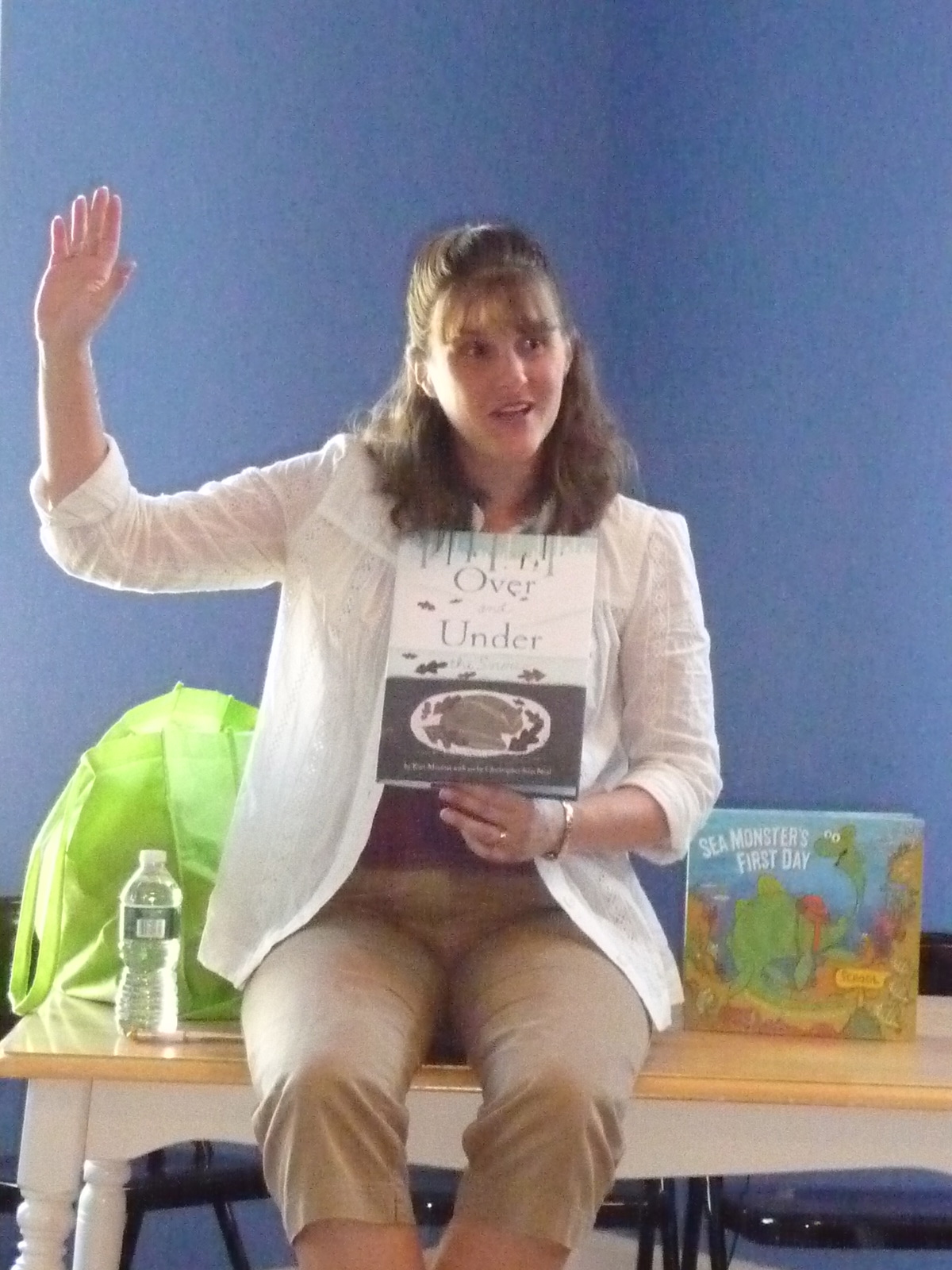 Kate Messner is an author’s author. She cares about craft, she reads voraciously, she’s generous with resources and information and encouragement toward her peers, both published and not yet published.
Kate Messner is an author’s author. She cares about craft, she reads voraciously, she’s generous with resources and information and encouragement toward her peers, both published and not yet published.
Kate is also a booksellers’ author. She puts her money where her mouth is, supporting the bookstores who support her books by shopping there and recommending those stores to her friends and family.
And most importantly, Kate is a readers’ author. She’s a marvelous and versatile storyteller, has an unerring sense of what will appeal to her child readers, and loves language without being precious or self-conscious about it.
Kate was planning to come to the Flying Pig to celebrate her new picture book, Over and Under the Snow, just out from Chronicle. I looove this book. It does for kids what Bernd Heinrich’s Winter World does for adults: provides a window into the fascinating way animals survive the snowy months. Here, a father and child cross-country ski through the woods, noticing evidence of the critters near them. (Pair this with Jane Yolen and John Schoenherr’s gorgeous Owl Moon; customers will be unable to resist them.)
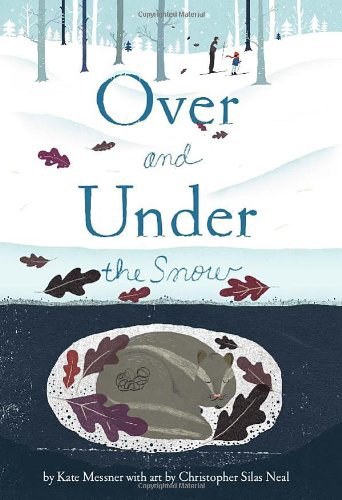 Over and Under the Snow is a soft and lovely book, with lyrical language and beautiful earth-tone-palette paintings by Christopher Silas Neal. There’s something delightful about the physical book itself: it’s a little bit surprisingly tall—suiting the ‘over/under’ subject matter—with a delicious matte cover that feels good in the hands. And the text is so satisfying, both simple and poetic. Plain in the best sense. “Over the snow, a deer has crossed our path. Deep hoof prints punch through the crust, up the hill, under a tree. An oval of melted snow tells the story of a good night’s sleep.” Each word is well chosen and just right. After the story is a helpful and appealing Author’s Note, which gives more detailed information about how each animal mentioned survives the winter, along with suggested further reading for kids, parents and teachers.
Over and Under the Snow is a soft and lovely book, with lyrical language and beautiful earth-tone-palette paintings by Christopher Silas Neal. There’s something delightful about the physical book itself: it’s a little bit surprisingly tall—suiting the ‘over/under’ subject matter—with a delicious matte cover that feels good in the hands. And the text is so satisfying, both simple and poetic. Plain in the best sense. “Over the snow, a deer has crossed our path. Deep hoof prints punch through the crust, up the hill, under a tree. An oval of melted snow tells the story of a good night’s sleep.” Each word is well chosen and just right. After the story is a helpful and appealing Author’s Note, which gives more detailed information about how each animal mentioned survives the winter, along with suggested further reading for kids, parents and teachers.
When we started discussing Kate’s upcoming author visit to the Flying Pig, she had a wonderful idea. “What if,” she suggested, “after the kids’ storytime and puppet show, I did a free picture-book writing workshop for adults and mature kids?” She then expanded the idea. “You know, you could have a whole series of these free workshops, if other authors are willing to do them.”
It was a brilliant brainstorm, especially as a way to draw people to events with authors who aren’t yet household names, but are fantastic presenters with a lot to offer. Fellow author (and former events guru for Vroman’s Bookstore in Pasadena) Linda Urban was having coffee with us during this discussion, and she added some terrific thoughts and suggestions. Thanks to Kate and Linda and some really good iced lattes, the Flying Pig “Words With Wings” writing workshop series was born. The basic format was to be this: a half-hour author event for the kids, followed by (and this is flexible) a two-hour workshop for adults.
So I made a flyer, and Kate shared it with her mailing list, and we shared it in the store and sent it out with our email blasts, and lo and behold, more than a dozen people signed up for the post-author-event workshop — on a Saturday afternoon during peak leaf season time on Columbus Day weekend. That was more than a dozen people who weren’t already attending the storytime portion of the author visit.
Kate also suggested some wonderful wording for the flyer: “Note: Our WORDS WITH WINGS: WRITING BOOKS FOR (AND WITH) KIDS series of workshops will be offered at no charge. Similar workshops are often priced at $100 or more per person, so if you can, we’d ask that you support our authors and illustrators and the bookstore by purchasing one or more signed books to keep for yourself, give as gifts, or donate to a classroom or library. Your support will allow us to continue this free workshop series in the future.” Thoughtful, true, and a useful message to share with the appreciative attendees.
The event itself was fantastic. The kids loved the puppet show and Kate’s books (she also read her cute Sea Monster’s First Day to them). And the writing workshop? It was a perfect introduction to the art of writing picture books, packed with helpful information and great ideas. The attendees left inspired and grateful to both Kate and the store. “When’s the next workshop?” someone asked eagerly on the way out. “I can’t wait!”
For bricks-and-mortar stores looking to communicate the value of what we offer to our communities, it’s wonderful to have author allies like Kate.

